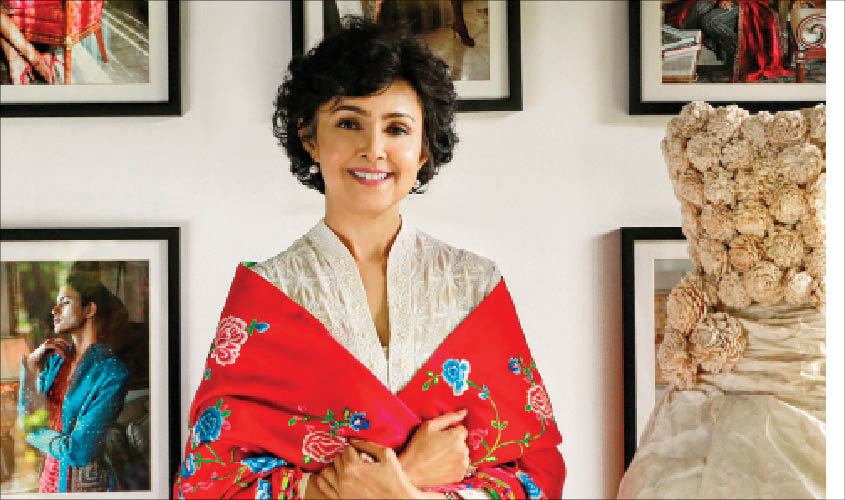Payal Jain is among the few designers who have driven India’s niche fashion industry of the ’90s towards the grand and glorious world of couture we see today. The prolific designer is known for seamlessly blending Indian craftsmanship with modern-day silhouettes. Each collection in her eponymous brand represents “a Western body with an Indian soul”. This is because the entire world looks at India for its textile heritage and fashion amalgamation, catering to the global audience.
Jain’s engagement with art began early in life, and then transformed into a professional pursuit in the field of fashion. She said, “I have had a childhood steeped in painting, sculpture and music. I went for every art exhibition, every musical concert in town. I took figure drawing classes when I was 10 years old. My sense of proportion, aesthetics and design evolved, growing to a passion for art and architecture. However, once I discovered my love for textiles and crafts, there was no looking back.” Jain believes that fashion is an art form and her seriousness is evidenced by artists, music and architecture serving as inspirations for most of her designs.
Even though Jain was greatly influenced by the works of great couturiers like Madeleine Vionnet, Paul Poiret and Coco Chanel during her college years, upon starting her studio in Delhi, she reconnected with her roots. Jain feels blessed to have been born an Indian and to have had the opportunity to work with the country’s rich legacy of textiles, embroideries and crafts.
The leading designer has been working to revive the dying crafts of India and has generated employment for neglected weavers and artisans of India. Jain uses their expertise and techniques and integrates them with her designs. She said, “More and more designers are now bringing in traditional techniques and promoting Indian crafts and textiles all over the world, thereby giving livelihood and renewed hope to a fast vanishing community. It is truly up to our generation of designers to bring this rich, varied and unique craft heritage of each of our states to the world, and make sure it translates into income for the revival of these dying traditions.”
Recently, Jain achieved the 25-year milestone in the fashion industry. Jain’s journey has been long and full of challenges. She returned to India from California with a degree in fashion in 1993, only to find that the market was at its nascent stage and the profession—of fashion design—was largely misunderstood.

She said, “In India those days, fashion was just beginning to emerge. When I started my label, fashion was a grossly misunderstood word in most people’s vocabulary. We designers were still treated as glorified tailors and no one understood that there was a skill and education required to pursue a career in fashion. Most people did not understand the role or relevance of fashion. Also, western women’s wear was practically non-existent in our country.”
According to Jain, there has been nothing short of a revolution in India’s fashion scene in the last decade. She has witnessed this firsthand with her active involvement with the Fashion Design Council of India (FDCI). The change in the Indian fashion sensibility has been quite unexpected for Jain, especially the reality of Indian women moving from traditional wear to Western silhouettes.
This development holds significance for Jain as she started designing Western outfits at a stage when it was neither heard of nor appreciated in India. She informed us that when she started her fashion label, most Indians believed that an outfit was “value for money” only if it was a sari or an Indian ensemble, as it would be preserved as an heirloom or passed down the generations. A beautifully draped gown or immaculately constructed suit was never their natural choice and certainly not an expensive one. Western outfits were limited to casual day wear, mostly donned by young people and a select few corporate ladies.
She said, “In those days, there was a minuscule market at best for this marriage between the East and West, but I believed it was my strength that got me through, against all odds. Slowly the customer sensibility evolved in India and from a handful of clients, my label now creates for a large segment of discerning women across the globe.”
From that time, Jain has certainly come a long way, and so has the popularity of her contemporary interpretations of classic Indian wear. Today, her clientele includes trendsetters such as Victoria Beckham, Priyanka Chopra, Deepti Naval and Saina Nehwal among many others.

Jain has also been actively involved with many
The fashion industry veteran feels deeply about the sustainability movement that the fashion industry is now in the grip of. She said, “Every small step goes a long way and if each one of our design community members makes it a part of their willful and conscious agenda, it will be a huge blessing to our future generations. From fast-fashion trends to the new collection every season, the fashion industry’s exploitative practices are leading to negative impacts every day and every hour. Fashion industry accounts for a large percentage of non-recyclable fabrics and garments. Designers the world over are becoming mindful of this reality and working relentlessly to create sustainable fabrics, reuse and recycle fashion products and experiment with new techniques. Natural and organic fabrics are taking over in a big way and design is becoming more focused on comfort and sustainability.”
Jain concluded with her design philosophy: “Each garment should be a resplendent journey, telling a unique story.” She has certainly seen her vision through and created a label that stands out for its eclectic, elegant and contemporary nature.

